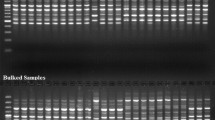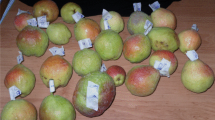Abstract
Iran has a long history of acid lime cultivation and propagation. In this study, genetic variation in 28 acid lime accessions from five regions of south of Iran, and their relatedness with other 19 citrus cultivars were analyzed using Simple Sequence Repeat (SSR) and Inter-Simple Sequence Repeat (ISSR) molecular markers. Nine primers for SSR and nine ISSR primers were used for allele scoring. In total, 49 SSR and 131 ISSR polymorphic alleles were detected. Cluster analysis of SSR and ISSR data showed that most of the acid lime accessions (19 genotypes) have hybrid origin and genetically distance with nucellar of Mexican lime (9 genotypes). As nucellar of Mexican lime are susceptible to phytoplasma, these acid lime genotypes can be used to evaluate their tolerance against biotic constricts like lime “witches’ broom disease”.






Similar content being viewed by others
References
Ahmad R, Struss D, Southwick SM (2003) Development and characterization of microsatellite markers in citrus. Am Soc Horticult Sci 128(4):584–590
Al-Sadi AM, Al-Moqbali HS, Al-Yahyai RA, Al-Said FA (2012) AFLP data suggest a potential role for the low genetic diversity of acid lime (Citrus aurantifolia swingle) in Oman in the outbreak of witches’ broom disease of lime. Euphytica 188:285–297
Awasthi AK, Kar PK, Srivastava PP, Rawat N, Vijayan K, Pradeep AR, RajeUrs S (2008) Molecular evaluation of bivoltine, polyvoltine and mutant silkworm (Bombyx mori L.) with RAPD, ISSR and RFLP-STS markers. Indian J Biotechnol 7:188–194
Bahrami H R, Faghihi M M, Akbari H, Hasanzadeh H (2011) Reaction of acid citrus cultivars of Hormozgan province and commercial citrus rootstocks to Witches’ broom disease of lime (WBDL). Proc of the 7th Iranian Hort Science Congr Isfahan Univ of Technol, Iran, 5–8 September. p. 358
Biswas MK, Xu Q, Deng X (2010) Utility of RAPD, ISSR, IRAP and REMAP markers for the genetic analysis of Citrus spp. SciHort 124:254–261
Bove JM, Danet JL, Bananej K, Hassanzadeh N, Taghizadeh M, Salehi M, Garnier M (2000) Witches’ Broom Disease of Lime (WBDL) in Iran. Fourteenth IOCV Conference, Insect-Transmitted Procaryotes. 41–42
De Riek J, Calsyn E, Everaert I, Van Bockstaele E, De Loose M (2001) AFLP based alternatives for the assessment of distinctness, uniformity and stability of sugar beet varieties. Theor Appl Genet 103:1254–1265
Faghihi MM, Bagheri AN, Bahrami HR, Hasanzadeh H, Rezazadeh R, Siampour M, Samavi S, Salehi M, Izadpanah K (2011) Witches’-broom disease of lime affects seed germination and seedling growth but is not seed transmissible. Plant Dis 95:419–422
Fang DQ, Roose ML (1997) Identification of closely related citrus cultivars with inter–simple sequence repeat markers. Theor Appl Genet 95:408–417
Frost HB, Soost RK (1968) Seed reproduction: development of gametes and embryos. The citrus industry. Univ. of California press. Berkeley vol 2:290–324
Golein B, Bigonah M, Azadvar M, Golmohammadi M (2012) Analysis of genetic relationship between ‘bakraee’ (Citrus sp.) and some known citrus genotypes through SSR and PCR-RFLP markers. Sci Hortic 148:147–153
Hodgson RW (1967) Horticultural varieties of citrus. In: Reuther W, Webber HJ, batchelor LD (eds.). the citrus industry. University of California press. Berkeley 1:431–591
Kijas JMH, Thomas MR, Fowler JCS, Roose ML (1997) Integration of trinucleotide microsatellites into a linkage map of citrus. Theor Appl Genet 94:701–706
Krueger RR, Roose ML (2003) Use of molecular markers in the management of citrus germplasm resources. J Amer Soc Hort Sci 128:827–837
Mantel N (1967) The detection of disease clustering and a generalized regression approach. Cancer Res 27:209–220
Marak CK, Laskar MA (2010) Analysis of phonetic relationship between Citrus indica Tanaka and a few commercially important citrus species by ISSR markers. Sci Hortic 124:345–348
Murray MG, Thompson WF (1980) Rapid isolation of high molecular weight plant DNA. Nucleic Acids Res 8:4321–4325
Novelli VM, Cristofani M, Machado MA (2000) Evaluation of microsatellite markers in cultivars of sweet orange (Citrus sinensis [L.] osbeck). Acta Horticult 535:47–49
Oliveira AC, Garcia AN, Cristofani M, Machado MA (2002) Identification of citrus hybrids through the combination of leaf apex morphology and SSR markers. Euphytica 128:397–403
Pang XM, Hu CG, Deng XX (2003) Phylogenetic relationships among citrus and its relatives as revealed by SSR markers. Acta Genet Sin 30:81–87
Peakall R, Smouse PE (2012) GenALEx 6.5: genetic analysis in Excel. Population genetic software for teaching and research – an update. Bioinformatics. doi:10.1093/bioinformatics/bts460
Roose ML (2000) Identification and use of genetic resistance and tolerance to new diseases. Proc Intl Soc Citricult IX Congr 952-954
Ruiz C, Breto MP, Asins MJ (2000) A quick methodology to identify sexual seedlings in citrus breeding programs using SSR markers. Euphytica 112:89–94
Rohlf FJ (2000) NTSYS-pc, Numerical taxonomy and multivariate analysis system. version 2.11. New York, Exeter, Setauket
Salehi M, Firooz R, Baradaran GH (2008) New distribution areas of witches, −broom disease of Lime in Iran. Proc 18th Plant ProtCongr, Iran, Tabriz University
Sanker AA, Moore GA (2001) Evaluation of inter–simple sequence repeat analysis for mapping in citrus and extension of the genetic linkage map. Theor Appl Genet 102:206–214
Shahsavar AR, Izadpanah K, Tafazoli E, Sayed Tabatabaei BE (2007) Characterization of citrus germplasm including unknown variants by inter-simple sequence repeat (ISSR) markers. Sci Hortic 112:310–314
Uzun A, Yesiloglu T, Aka-Kacar Y, Tuzcu O, Gulsen O (2009) Genetic diversity and relationships within citrus and related genera based on sequence related amplified polymorphism markers (SRAPs). Sci Hortic 121:306–312
Uzun A, Gulsen O, Yesiloglu T, Aka-Kacar Y, Tuzcu O (2010) Distinguishing grapefruit and pummel accessions using ISSR markers. Czech J Genet Plant Breed 46:170–177
Watanabe M, Yamamoto T, Ohara M, Nishitani C, Yahata S (2008) Cultivar differentiation identified by SSR markers and the application for polyploidy loquat plants. J Japan Soc Hort Sci 77:388–394
Author information
Authors and Affiliations
Corresponding author
Rights and permissions
About this article
Cite this article
Sharafi, A.A., Abkenar, A.A., Sharafi, A. et al. Genetic variation assessment of acid lime accessions collected from south of Iran using SSR and ISSR molecular markers. Physiol Mol Biol Plants 22, 87–95 (2016). https://doi.org/10.1007/s12298-016-0336-4
Received:
Revised:
Accepted:
Published:
Issue Date:
DOI: https://doi.org/10.1007/s12298-016-0336-4




